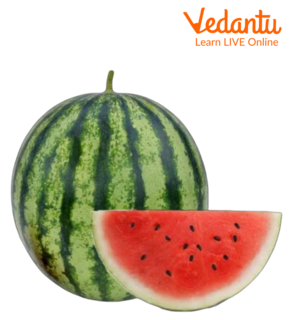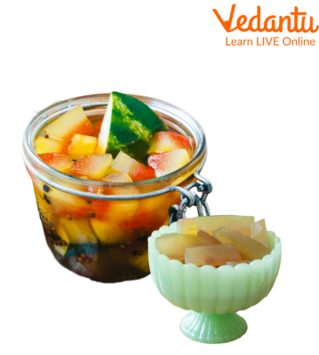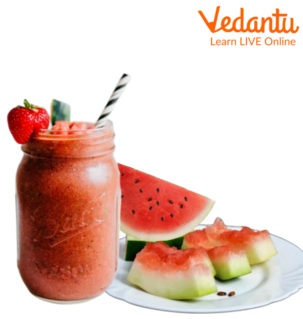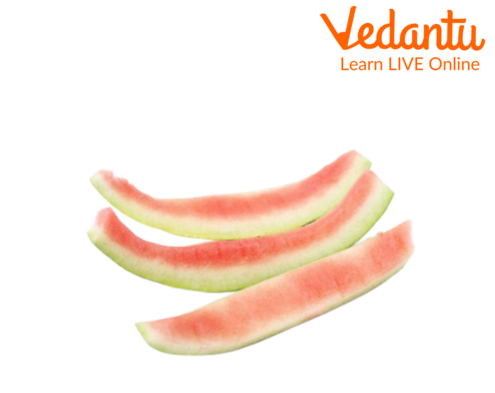




About Watermelon
People eat watermelon in summer. This fruit contains the most water, which protects the body from dehydration. Often you will eat the pulp of a watermelon and throw away the watermelon rind part of it. Whoever eats such a thick peel, watermelon peel is also very beneficial for health. Watermelon contains about 90% of water. Talking about the nutrients present in it, this fruit is rich in vitamins A, C, potassium, iron, lycopene, fibre etc.

Watermelon
What is Watermelon Rind?
The rind of a watermelon is the tough, outer layer of a watermelon, and is typically green on the outside, before giving way to the red and pink flesh of the fruit, which turns pale white on the inside. The rind is decidedly tougher and less juicy than the fruit it protects, but contrary to what many people think, it is perfectly edible. However, simply chewing on the rind of the watermelon may not be the tastiest or most efficient way to enjoy this part of the fruit.
The peel of this fruit contains a large percentage of the nutrients within the whole fruit, yet most people throw the peels in the garbage without a second thought. Not only do watermelon rinds contain all the nutrients found in the juicy fruit, but they also contain higher concentrations of certain antioxidants, minerals, vitamins and active ingredients.
This hard peel has low-calorie levels, but high amounts of vitamin C, vitamin A, vitamin B6, potassium and zinc. Watermelon rind is also rich in nutrients with chlorophyll, citrulline, lycopene, amino acids and flavonoids and phenolic compounds.
Watermelon Rind Uses
Although you can eat the rind of watermelon as it is, there are other ways to prepare it that can make it a little more flavourful. For example, a favourite of many in the southern United States, per Country Living, is homemade pickled watermelon rind. These pickles taste surprisingly easy to make and are also very tasty. The peels can also be juiced or mixed to give your summer drink some subtle watermelon flavour. So this summer, remember to put those peels and put them to good use.

Watermelon Rind Pickles

Watermelon Rind Smoothie
Watermelon Rind Health Benefits
Watermelon Rind Nutrition: Watermelon rind is high in vitamin A, vitamin C, potassium and magnesium. They are also high in fibre, which aids in digestion and subsequently helps control blood sugar levels and cholesterol levels. Eating watermelon rinds has also been shown to lower blood pressure due to their high levels of citrulline. Citrulline supplements have been linked to heart health and improved blood circulation overall.
There are many health benefits of the watermelon rind. Some benefits are given below:
Good source of fibre
Helps to control blood pressure
Contains amino acid (which is good for health)
Aids in digestion
Low cholesterol levels
Aid skin health
Improve immune system
What is a Watermelon Rind Good for?
Watermelon rind is rich in nutrients, but still, most people throw it in the garbage without thinking. It is rich in antioxidants, minerals, vitamins and some active ingredients. These peels are low in calories, but they are rich in vitamin C, vitamin A, vitamin B6, potassium and zinc. Apart from this, nutrients like chlorophyll, citrulline, lycopene, amino acids, flavonoids and phenolic compounds are also found in watermelon peel.

Watermelon Rind
Solved Questions
1. Write two benefits of watermelon rinds.
Two benefits of watermelon rinds:
Protects the body from dehydration.
Helps to control blood pressure
2. Write two uses of watermelon rinds.
Two uses of watermelon rinds:
Homemade watermelon rind pickles.
Watermelon rind smoothie/summer drink.
3. Can we eat raw watermelon rinds?
Yes. We can eat completely raw watermelon rinds. It will taste more like a cucumber.
Learning by Doing
Write True or False.
Watermelon rinds dehydrate the body.
The watermelon rind is red.
We can make pickles from watermelon rind.
Watermelon rinds have many health benefits.
Summary
When eating a piece of watermelon, the discarded part is usually a whitish green on the outside of the fruit, called the rind. Most people don't do much with the peel, even though watermelon rinds have many uses and can be pickled, added to food dishes, or studied for medicinal benefits. We have already studied all this in the chapter.
FAQs on Watermelon Rind Benefits
1. What are the other uses of watermelon rinds?
Uses of watermelon rinds:
Helps to lower cholesterol levels.
Helps in digestion.
2. Write two facts about watermelon.
Facts about watermelon rinds:
The scientific name of the watermelon is Citrullus lanatus.
The word watermelon first appeared in the English dictionary in 1615.
3. What is Citrulline?
Watermelon rind contains an amino acid called citrulline that removes nitrogen from the blood in the human body and helps convert it into urine. It also has many medicinal properties such as preventing heart diseases.









